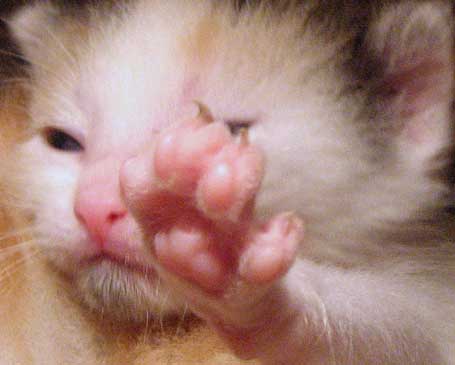I have always adopted adult cats. Maybe next time, I’ll be different. And if and when I do adopt a kitten I’ll make sure that she is accustomed to certain treatments. This way when I am called upon to apply these treatments to her as an adult cat, she will accept them, making the whole process relatively easy.
Just as socialising a cat to people and other animals is best done when she is a kitten, we can also get her accustomed to accepting certain essential maintenance treatments.
Here are some examples:
Trimming Claws
In general cats don’t like people fiddling around with their claws in an attempt to trim them, which makes it hard to trim them because precision is required. Kittens should ideally become accustomed to having their paws handled and claws trimmed. The use of positive reinforcement with treats will assist.

Cats that are permanently indoors should be trained to use a scratching post. This helps to wear down the front claws. It also removes the outer sheath. However, as natural wear is less likely to take place indoors it is likely that claws will still need to trimmed despite using a scratching post.
Also older cats, even if they go out, will need to have their claws checked for excessive growth and possible ingrowing claws into the paw pads. Older cats are much less active leading to overly long claws.
Another type of cat that needs extra attention are polydactyl cats. Sometimes the extra toes are not used in the same way as the normal toes resulting in the claws growing too long.
You can get nail clippers designed for trimming a cat’s claws. It should be done with care and precision. By gently squeezing a toe between your thumb and finger the claw will protrude. Careful inspection of the claw reveals the clear part of the nail and the area where there are nerves and blood vessels. Be sure to only trim away the clear part. If in doubt play safe and trim a small bit of the nail off until you are more familiar with the anatomy.
Dare I say it – never force the process. Do it promptly and without fuss. That requires training yourself as well as your cat. Why aren’t vets training people on a regular basis and promoting the service?. Depending on the ‘patients’ acceptance, probably the best way is to do one nail and return later for the next and so on as the objective is to train your kitten to accept nail trimming. If you are unsure about it ask your vet the next time you are visiting.
If your vet suggests declawing your cat, reprimand him severely and remind him that he is in breach of his oath!
Grooming
In general cats like being groomed by their human companion. However, a long haired cat might object and long haired cats do benefit from grooming by their caretaker. Kittens should be groomed in short sessions daily. The process can begin at about 4 – 5 weeks of age. Obviously gentleness is key. Never pull on a cat’s fur.
Adult long haired purebred cats such as the Persian, should be groomed daily. They have very long coats. Older cats also need more regular grooming because they are unable to do it adequately themselves.
Dental Care
Brushing your cat’s teeth is a cat maintenance treatment that rarely takes place. It is just too difficult. However, if a kitten is accustomed to it, it will certainly make it easier.
Gum disease is one of the most common health problems for cats and dogs. Some individuals are resistant to periodontal disease while others are predisposed to it. A good cat caretaker inspects his cat’s teeth regularly. You can get a good look when your cat yawns.
Here is a picture of a cat with inflammation of the gums (gingivitis):

If you like the idea of brushing your cat’s teeth you should start it when your cat is a kitten. This will accustom her to the process when she is an adult. You’ll need to use special cat toothpaste, which is flavored for cats, and you can buy products to apply the toothpaste as well.
Note: a kitten does not need her teeth cleaned as only permanent teeth need cleaning but this is about getting her used to it.
The advantage of doing all you can to improve your cat’s dental health is that having a cat’s teeth cleaned by a vet requires a general anesthetic and that process carries a risk of injury and even death in very rare cases.
Cats will almost certainly resist having their teeth brushed. A gradual introduction such as this…
- 1st: rub cat’s muzzle over the teeth
- 2nd: raise lip and massage gum with finger
- 3rd: rub teeth with gauze around finger
- 4th: start using toothpaste with soft brush (or gauze around finger)…
….may work nicely.
Can you think of anything else a cat should be acclimatised to?

